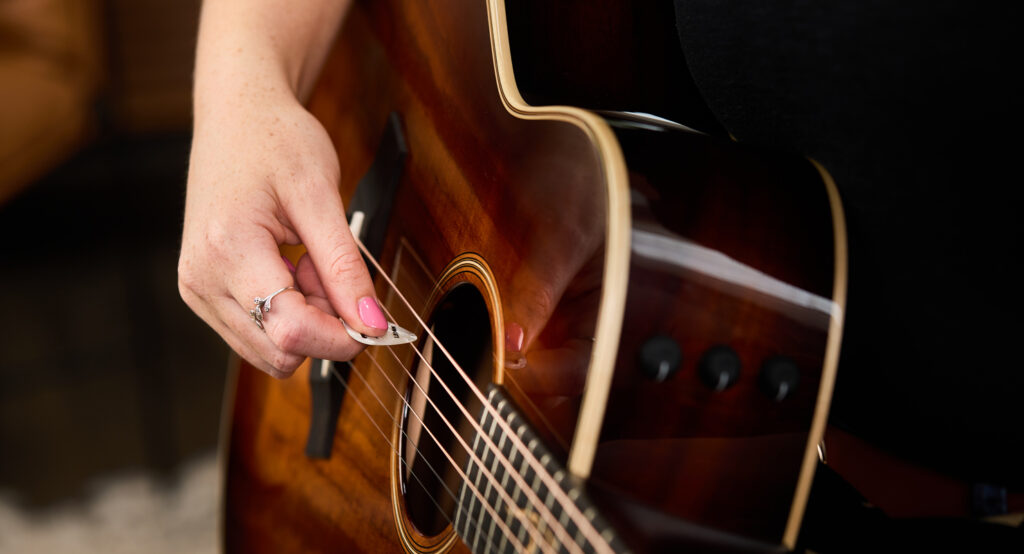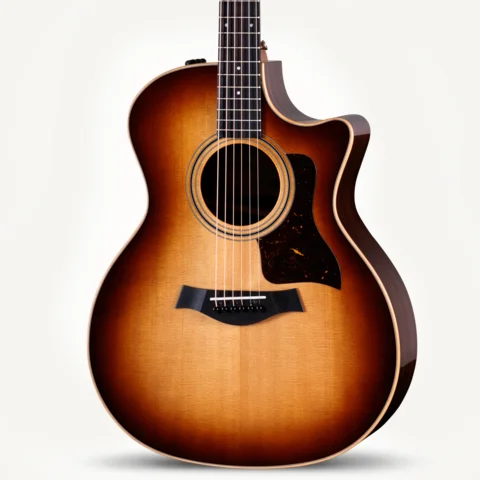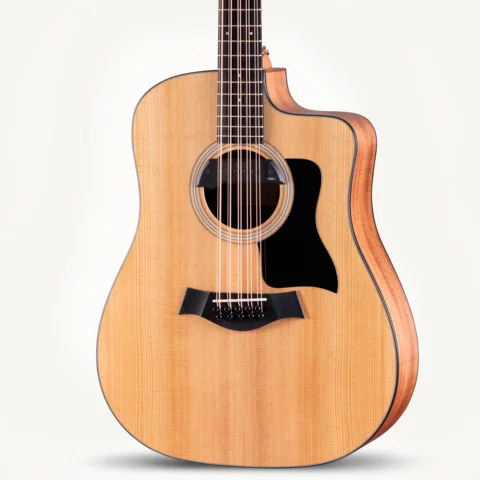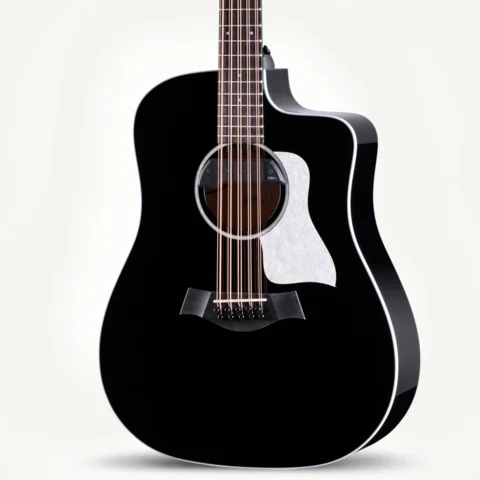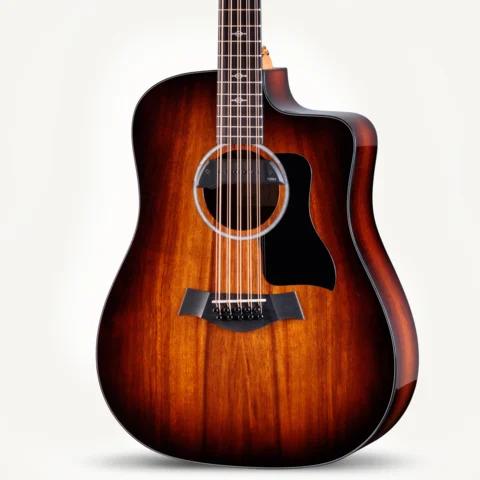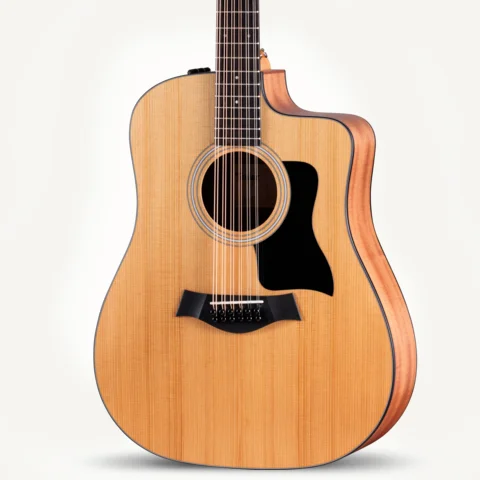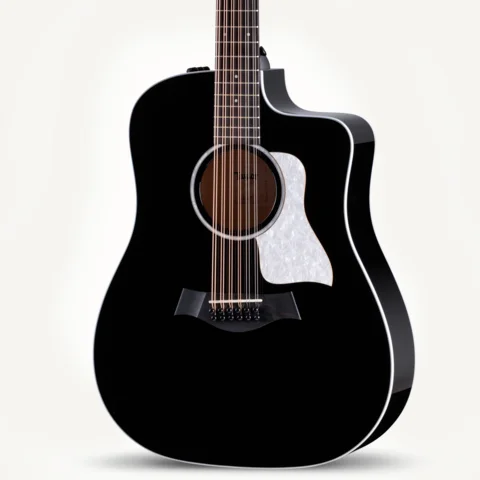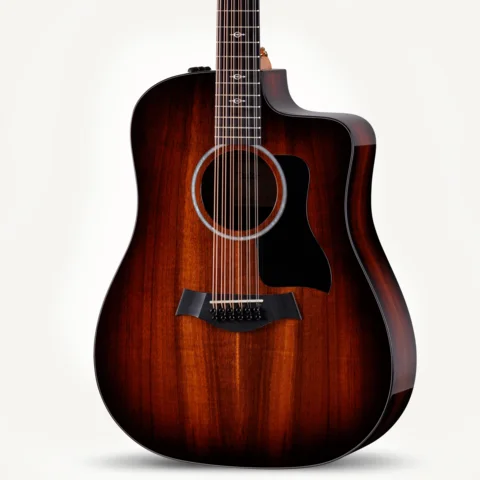For such a simple tool, the guitar pick can profoundly impact the way we play the guitar. Different picks produce different sounds. Some picks will feel comfortable in your hand; others may not.
Perhaps most importantly, the way you hold a pick influences your interaction with the guitar.
Playing with a guitar pick isn’t a must, but if you want to learn to use one, you’re in the right place. We’ll be diving into the world of guitar picks: where they came from, what to look for when choosing them and how to hold them.
A Brief History of the Guitar Pick
Guitar picks are a relatively new phenomenon in Western music, but in Asia and Northern Africa, the use of picks on stringed instruments dates back thousands of years. These original plectrums were fashioned from bone, wood, tortoise shell and more.
In the early 20th century, picks entered Western guitar music via the jazz and country scenes. Banjo players were playing with finger and thumb picks, and the guitarists of the day adopted those same tools to compete in volume. Metal finger and thumb picks quickly became essential, as early steel strings were tough on the fingers.
Flat picks—the teardrop-shaped implements most will be familiar with—were initially made of tortoise shell, a rare and rather delicate material. In 1922, Luigi D’Andrea solved these issues by creating picks out of stamped celluloid. Though minor tweaks have occurred over the years, D’Andrea’s design has been the foundation of guitar picks for the last 100 or so years.
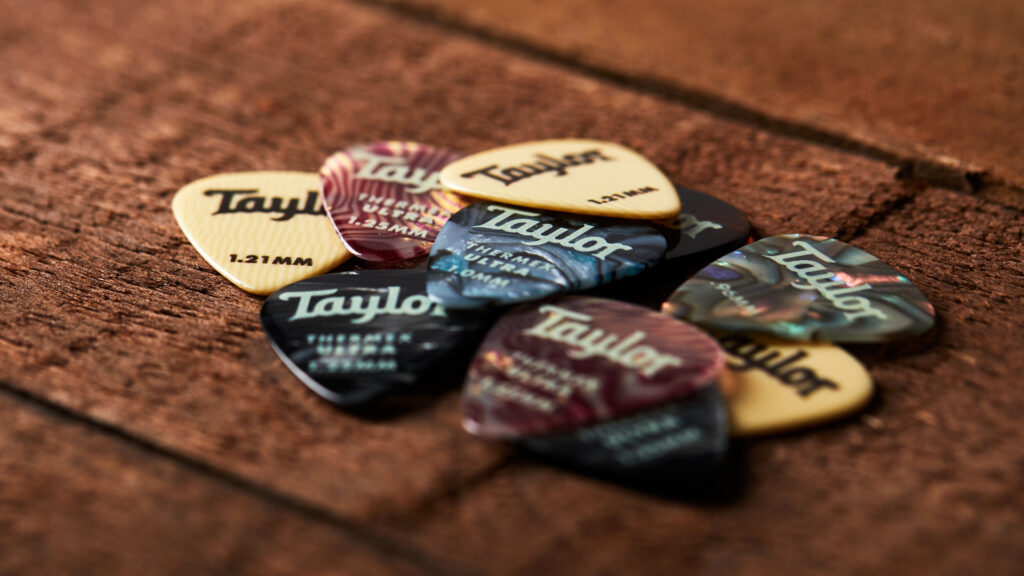
Choosing the Right Guitar Pick
Guitar picks may seem small and inconsequential, but they play a significant role in the way we make music. There are several factors to consider when selecting the right guitar pick. To help you choose the best guitar pick for your needs, let’s take a look at some of these attributes.
Material
A guitar pick’s composition influences the sound of the acoustic guitar and the overall feeling the player experiences when strumming. Brian May of Queen famously uses a sixpence coin as a pick. Some players favor stone picks, while others avoid them entirely to achieve their desired tone.
Guitar picks come in dozens of materials and combinations, but we’ll focus on three common ones.
- Celluloid – Typically associated with a trebly response, celluloid picks sound bright and articulate. As the earliest flat picks were made of celluloid, this material gives players a traditional, recognizable sound.
- Ivoroid – Ivoroid is known for delivering a warm, midrange presence. These picks are made from a blend of premium celluloid and given a grained look to resemble genuine ivory.
- Blended materials – A pick made from blended materials will give guitarists a deeper, bass-heavy response. While the materials used can vary, these picks are often made of high-quality thermoplastics.
Thickness
A pick’s thickness will also affect the sound. Different guitar picks vary in thicknesses and are measured in millimeters. They react differently with the strings based on the amount they bend.
Thinner picks are associated with lower volume output and have a brighter sound. The initial attack of a thinner pick is quite strong but fades quickly. Beginners may find it easier to start with thin picks in the .41 to .88 mm range.
Thicker picks don’t have as much give, which translates to a warmer, louder sound. Thick picks (from around .96 mm and above) are popular with more advanced players, and you’ll often see them in bluegrass and metal.
Ultimately, the thicker the pick, the more tonal control the player has, which is why we recommend playing with the pick you find most comfortable. Determining your preferred pick thickness comes down to experimenting with various picks.
Shape
When it comes to the shape and size of a guitar pick, variations are less about tone and more about the way it feels in your picking hand. With that said, the point of the pick can have a minor yet noticeable effect on the sound.
Guitar picks are in all shapes and sizes, from large and triangular to narrow, oblong shapes. But the majority of picks you’ll come across will likely be one of three familiar shapes. They are:
- The 351 – This is perhaps the shape that most will recognize. The 351 is like a rounded pyramid, a little taller than it is wide. The rounded tip serves to slightly dampen high frequencies.
- The 346 – This is a larger pick that looks like a rounded equilateral triangle. Because all three sides are identical, you can use any of them to hit the guitar strings. The large body of the 346 produces a big, round tone.
- The 651 – These small and pointed teardrop-shaped picks are favored by jazz players and quick-picking guitarists. The point of the 651 gives a slight treble boost.

Proper Pick Technique
As with many things guitar-related, there’s technically no “right way” to hold a pick. Guitar players—especially self-taught ones—have found an abundance of methods to handle their picks. Rules are meant to be broken, right?
Even so, some ways are better than others—certainly from an ergonomic standpoint. Learning the correct pick technique as a beginner is a critical skill that can help you progress quickly and avoid injuries in the long run. Here’s a step-by-step rundown on how to hold a guitar pick:
- Choose the correct hand – If you play right-handed (fretting with your left hand), hold the pick in your right hand. Lefties, hold the pick in your left hand.
- Position the pick – Shape your hand into a relaxed fist as if you were holding a coffee mug. Place the guitar pick on top of your index finger with a little less than half an inch sticking out past the fingertip. The point of the pick should face the same direction as your finger.
- Hold on – Lower your thumb to cover the bulk of the pick. The pointed part of the pick will be perpendicular to your thumb.
The pick is supported by the thumb and the first finger or two. Some players curl and stack their other fingers up below the index finger, while some let them hang free. Try experimenting and see what feels best.
In terms of gripping the pick, take the Goldilocks approach: not too loose, but not too tight. A loose grip increases the chances of dropping the pick. Squeezing too tightly can cause cramping.
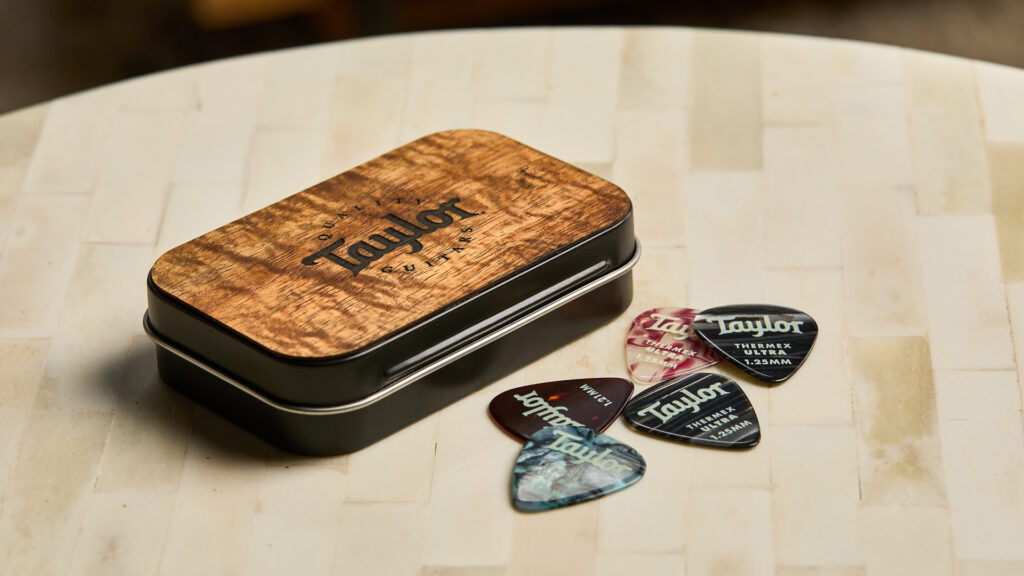
How to Improve Picking
Once you’ve perfected holding a guitar pick, you can work towards improving your picking speed and accuracy with these tips.
Alternate Picking
When you play a riff or the individual notes of a chord, your first instinct may be to pluck each string with a downward stroke. While this might seem like the most straightforward approach, it’s not the best habit to fall into. This downstroke-only technique is fine at slower speeds, but it can be challenging to keep up once you increase the tempo.
That’s where alternate picking comes in. This technique encourages an economy of motion. Instead of playing each string with a downward motion, alternate between picking “down” and picking “up” each time you change notes. Right away, you’ll notice you can play faster.
As you progress, you can employ alternate picking in a way that sets up the following note. For example, if a riff went from the B string to the G string, you would pick upwards on the B to anticipate playing downwards on the G.
Gradually Increase Speed
It’s easy to get caught up in the excitement of a new instrument. Playing lightning-fast right away is always a temptation. But jamming at full speed from the get-go can lead to the formation of bad habits that may go unnoticed.
Instead, try slowly increasing your playing speed as you learn new songs or scales. Start at half speed, then take it up from there. This allows you to work on proper picking techniques first, which you can then apply to songs at their regular tempo.
Practicing scales or strumming along to a steadily accelerating metronome can also help you develop your picking speed. You can do this yourself if you own a metronome, or you can practice to one of the many YouTube videos of accelerating click tracks.
Play Every Day
Keeping a consistent schedule is the best way to improve picking speed and accuracy. Try to find time each day to sit down with the guitar and practice. If you find yourself improving as the days go by, try varying the sonic flavor of your playing. For example, try picking the string closer to the bridge. This will result in a brighter, more defined note. On the other hand, for a stronger bass response with your picking, move toward the neck.
Remember that practicing the guitar doesn’t need to look like hours and hours of scales. Playing every day, whether it be songs or exercises, is what’s important—even if it’s only 20 minutes a day.
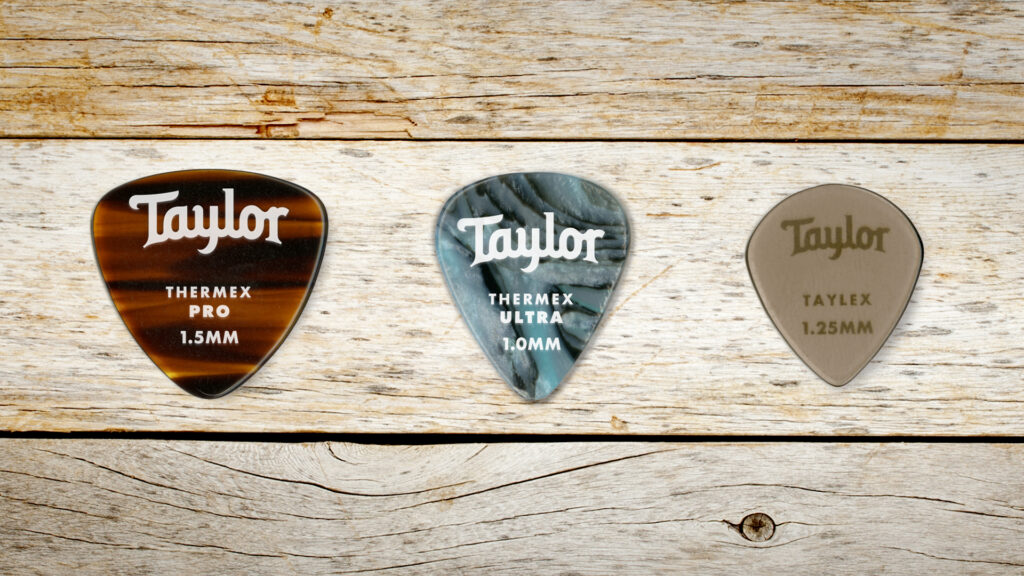
Experiment with Your Picks
Now that you know how to hold a guitar pick, it’s time to discover which kind you prefer. And the best way to know which pick suits your playing is to try them out.
At Taylor Guitars, we know that no two players are alike—right down to the pick they use. That’s why we offer a range of premium guitar picks geared towards guitarists of all levels and styles.
Can’t decide which to try first? The Darktone Series Pick Tin contains a variety of picks so that you can experiment with different sizes and materials.
If you’re ready to keep learning the basics, check out our guides on topics like how often should you change guitar strings and How to Put on a Guitar Strap.

























